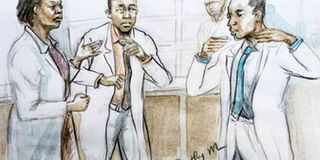Prime
The murder trial of Nyangasi Part 3

What you need to know:
- The pathologist who carried out the postmortem examination on the body of the deceased stated in the report that the cause of death was a bronchopneumonia.
One of the cardinal issues in the trial of Apollo Dalton Nyangasi, the on- time chairperson of the Medical Workers Union, was whether his wife Christine Nyangasi Dambio’s death was unlawful or, in truth, she died of natural causes.
The pathologist who carried out the postmortem examination on the body of the deceased stated in the report that the cause of death was a bronchopneumonia.
However, on the death certificate the pathologist recorded the conditions directly leading to death as cardiac arrest, trauma and a resolving pneumonia, an apparent and important contradiction to what was in the postmortem report.
A professor of pathology, who testified as a defense witness, told court that from the postmortem report and the medical certificate of cause of death, Christine died of natural causes.
The professor of pathology was of the opinion that the histology report, prepared on November 25, 2010, was more scientific and more reliable than the opinion in the Medical Certificate of the Cause of Death that was written on August 17, 2010.
Consistency
The junior pathologist, moreover, told court that when he examined the body of the deceased he did not find any injuries on the neck.
The defence lawyer submitted to court that neurogenic shock could be triggered off by many other events, including the passing of hard stool in a patient who is constipated.
He told court that from the evidence of eye witnesses the deceased had soiled herself and was found breathing badly.
The tissues of the deceased were examined under the microscope and a histology report was submitted to court.
In the report the pathologist concluded that the cause of death was bronchopneumonia, a disease that affects the young and the elderly and the immune suppressed.
However, the pathologist told court, under cross-examination, that he did not ascertain the immune status of the deceased.
A person is deemed to have caused the death of another person if by some unlawful act or omission he or she hastened the death of a person suffering from any disease or injury which apart from such act or omission would have caused death.
In the instant case it was found at the postmortem examination that the lower lobes of the lungs were consolidated.
This meant that the deceased had a health condition or disease.
The pathologist who examined the body of the deceased informed court that in his opinion, the disease in the lungs was severe but he did not think that it would have caused the death of the deceased.
The doctor further explained that the histology report should not be looked at in isolation of other medical reports and the events surrounding the death of the deceased. He was of the opinion that the cause of death was pressure on the neck leading to neurogenic cardiac arrest.
Court was of the opinion that the evidence of the professor of pathology did not fundamentally contradict that of his junior colleague and court, therefore, agreed with the conclusions of the junior doctor.
Court further noted that although the deceased may have had health issues she was, generally speaking, healthy.
Alibi
Appollo Nyangasi in his unsworn testimony told court that on July 24, 2010 that he woke up early as he usually did and came out and went to where his wife was sleeping and told her to call her matron so that she could intervene in their relationship that had escalated so badly.
To court this was not the sort of conversation one holds with a very sick woman beleaguered with pneumonia.
Court relied on the testimony of the witness who saw Christine walking to the toilet and then her husband following her and Christine’s scream in the toilet.
The witness also told court that she saw Nyangasi’s hands around Christine’s neck and that she saw Christine trying to free herself. That Christine died shortly after these series of events was not in question.
Satisfactory
Court, after looking at the evidence in totality, was satisfied that Christine’s death was unlawful.
Fatal pressure on the neck may occur, among other causes, due to manual strangulation, ligature strangulation, arm-locks, direct blows and entanglement of the neck with the umbilical cord.
One of the causes of death in these cases is obstruction of the airways and another is compression of the blood vessels in the neck. When these blood vessels are occluded, the person will immediately become unconscious as blood circulation to the brain is immediately compromised.
In ordinary circumstances, permanent brain damage occurs if the blood supply to the brain is cut off for more than five minutes.
The arteries in the neck have in them nerves that are very sensitive to pressure and may cause slowing of the heart or even total cardiac arrest.
It is an undisputable fact that collapse and apparent death can occur immediately on application of pressure on the neck.
Death that occurs suddenly following pressure on the neck can be totally unexpected especially when even a relatively slight pressure is applied to the neck.
The slowing of the heart can then lead to heart failure and therefore accumulation of fluids in the lungs and an inexperienced pathologist can misinterpret this as pneumonia.
This is what probably happened when the junior pathologist examined the lungs of Christine under the microscope. However an important legal question is whether unexpected death following pressure on the neck should be considered murder or manslaughter.
To be continued




